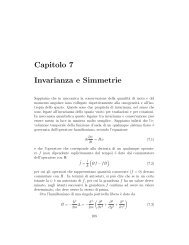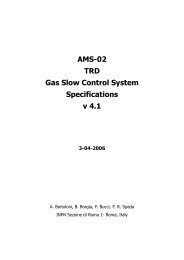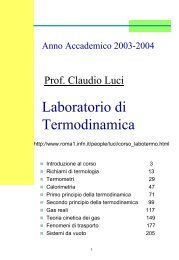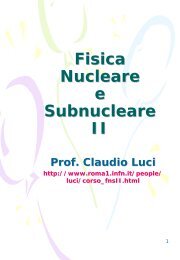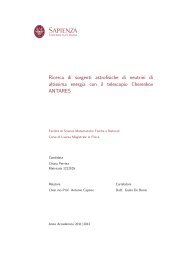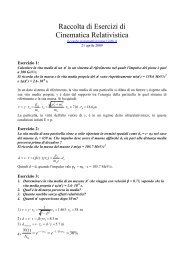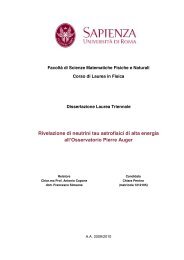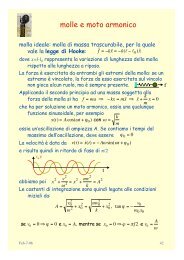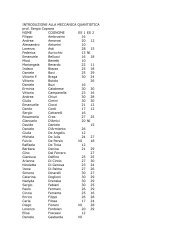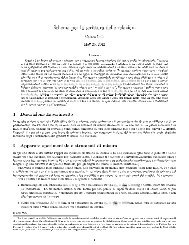You also want an ePaper? Increase the reach of your titles
YUMPU automatically turns print PDFs into web optimized ePapers that Google loves.
Chapter 4<br />
<strong>Geodesics</strong> <strong>of</strong> <strong>the</strong> <strong>Kerr</strong><br />
<strong>metric</strong><br />
Here we will study <strong>the</strong> geodesic motion outside a <strong>Kerr</strong> black hole;<br />
<strong>the</strong>refore, we will only consider <strong>the</strong> region outside <strong>the</strong> outer horizon,<br />
r ≥ r + (4.1)<br />
which is <strong>the</strong> relevant region for astrophysical considerations.<br />
Let us consider a geodesic with affine parameter λ and tangent<br />
vector<br />
u µ = dxµ<br />
dλ ≡ ẋµ (4.2)<br />
in Boyer-Linquist coordinates (we remind that, in our conventions,<br />
<strong>the</strong> overdot has <strong>the</strong> meaning <strong>of</strong> derivation with respect to <strong>the</strong> affine<br />
parameter λ). The tangent vector u µ is solution <strong>of</strong> <strong>the</strong> geodesic<br />
equation<br />
u µ u ν ;µ =0. (4.3)<br />
The geodesic equation (4.3) is equivalent to <strong>the</strong> Euler-Lagrange<br />
equations<br />
d ∂L<br />
dλ ∂ẋ = ∂L<br />
(4.4)<br />
α ∂x α<br />
associated to <strong>the</strong> Lagrangian<br />
L (x µ , ẋ µ )= 1 2 g µνẋ µ ẋ ν . (4.5)<br />
One can define <strong>the</strong> conjugate momentum p µ to <strong>the</strong> coordinate x µ as<br />
p µ ≡ ∂L<br />
∂ẋ µ = g µνẋ µ . (4.6)<br />
67
In terms <strong>of</strong> <strong>the</strong> conjugate momenta, <strong>the</strong> Euler-Lagrange equations<br />
can be written as<br />
d<br />
dλ p µ = ∂L<br />
∂x . (4.7)<br />
µ<br />
Notice that, if <strong>the</strong> <strong>metric</strong> does not depend on a given coordinate x µ ,<br />
<strong>the</strong> corresponding conjugate momentum is a constant <strong>of</strong> motion.<br />
The existence <strong>of</strong> such a constant can also be seen in a simpler way.<br />
We know that, if <strong>the</strong> <strong>metric</strong> is independent by a coordinate, <strong>the</strong>re<br />
is a Killing vector ξ µ corresponding to this symmetry, and ξ µ ẋ µ<br />
is a constant <strong>of</strong> geodesic motion; actually, this constant <strong>of</strong> motion<br />
coincides with <strong>the</strong> one arising from Euler-Lagrange equations (as we<br />
will see, for instance, in <strong>the</strong> case <strong>of</strong> t and φ for <strong>the</strong> <strong>Kerr</strong> <strong>metric</strong>).<br />
Let us come back to <strong>the</strong> geodesic equation for <strong>Kerr</strong> spacetime.<br />
Equation (4.3) (or, equivalently, (4.4)) in <strong>Kerr</strong> spacetime is very<br />
complicate to solve directly. To study geodesic motion in a simple<br />
way, we would need to find a way to express <strong>the</strong> geodesic u µ in terms<br />
<strong>of</strong> conserved quantities, as we have done in <strong>the</strong> case <strong>of</strong> Schwarzschild<br />
spacetime. For this, we need four algebraic relations involving u µ .<br />
As we have seen in Section 3.2, <strong>Kerr</strong> spacetime has two Killing<br />
vectors: a timelike Killing vector k µ =(1, 0, 0, 0) and a spacelike<br />
killing vector m µ =(0, 0, 0, 1). This corresponds to <strong>the</strong> fact that <strong>the</strong><br />
<strong>metric</strong> (in Boyer-Lindquist coordinates) does not depend explicitly<br />
by t and φ: <strong>the</strong> spacetime is stationary and axially sym<strong>metric</strong>.<br />
Therefore, in geodesic motion <strong>the</strong>re are two conserved quantities:<br />
E ≡ −k µ u µ = −g tµ u µ = −p t constant along geodesics<br />
(4.8)<br />
L ≡ m µ u µ = g φµ u µ = p φ constant along geodesics .<br />
(4.9)<br />
As explained in Section 3.2, in <strong>the</strong> case <strong>of</strong> massive particle E is <strong>the</strong><br />
energy at infinity per mass unit while L is <strong>the</strong> angular momentum<br />
per mass unit; in <strong>the</strong> case <strong>of</strong> massless particles, E is <strong>the</strong> energy at<br />
infinity and L is <strong>the</strong> angular momentum.<br />
Fur<strong>the</strong>rmore, we have <strong>the</strong> relation<br />
where<br />
κ = −1<br />
g µν u µ u ν = κ (4.10)<br />
for timelike geodesics<br />
68
κ =1 forspacelikegeodesics<br />
κ =0 fornullgeodesics. (4.11)<br />
The relations (4.8), (4.9), (4.10) give us three algebraic relations<br />
involving u µ ,but<strong>the</strong>yarenotsufficienttotodetermine<strong>the</strong>four<br />
unknowns u µ . This is different from <strong>the</strong> case <strong>of</strong> Schwarzschild spacetime,<br />
where we have <strong>the</strong> fur<strong>the</strong>r condition <strong>of</strong> planarity <strong>of</strong> <strong>the</strong> orbit<br />
(u θ (λ) ≡ 0 if θ(λ =0)=π/2 andu θ (λ =0)=0)arisingfrom<strong>the</strong><br />
Euler-Lagrange equations, which have a simple form in that case.<br />
Without this fur<strong>the</strong>r condition, we cannot study geodesic motion<br />
using only (4.8), (4.9), (4.10). Actually, <strong>the</strong>re is a fur<strong>the</strong>r conserved<br />
quantity, <strong>the</strong> Carter constant, whichallowst<strong>of</strong>ind<strong>the</strong>tangentvector<br />
u µ through algebraic relations.<br />
Anyway, it is possible to study geodesic motion with <strong>the</strong> only help<br />
<strong>of</strong> (4.8), (4.9), (4.10) in <strong>the</strong> particular case <strong>of</strong> equatorial motion, i.e.<br />
with θ ≡ π/2. Therefore, we will first study equatorial geodesics,<br />
and <strong>the</strong>n, in Section 4.2, we will consider <strong>the</strong> case <strong>of</strong> general motion<br />
and derive <strong>the</strong> Carter constant.<br />
4.1 Equatorial geodesics<br />
In this section we study equatorial geodesics, i.e. geodesics with<br />
θ ≡ π 2 . (4.12)<br />
First <strong>of</strong> all, let us prove that such geodesics exist, i.e. that equatorial<br />
geodesics are solutions <strong>of</strong> <strong>the</strong> geodesic equation (4.3), or, equivalently,<br />
<strong>of</strong> <strong>the</strong> Euler-Lagrange equations (4.4). The θ component <strong>of</strong><br />
(4.4) is<br />
d<br />
dλ (g θµẋ µ )= d<br />
dλ (Σ ˙θ) =Σ¨θ +Σ ,µ ẋ µ 1<br />
˙θ =<br />
2 g µν,θẋ µ ẋ ν (4.13)<br />
where we have used <strong>the</strong> fact that <strong>the</strong> only non-vanishing g θµ component<br />
in (3.1) is g θθ =Σ.<br />
The right-hand side is<br />
( )<br />
(ṙ)<br />
g µν,θ ẋ µ ẋ ν 2<br />
=Σ ,θ<br />
∆ +(˙θ) 2 + 2 sin θ cos θ(r 2 + a 2 )( ˙φ) 2<br />
−<br />
2Mr (<br />
Σ Σ 2 ,θ a sin 2 θ ˙φ<br />
) 2 4Mr<br />
(<br />
− ṫ + a sin 2 θ<br />
Σ<br />
˙φ<br />
)<br />
− ṫ 2a sin θ cos θ ˙φ<br />
(4.14)<br />
69
where Σ ,θ = −2a 2 sin θ cos θ and Σ ,r =2r. It is easy to check that<br />
θ ≡ π/2 is a solution <strong>of</strong> equation (4.13).<br />
If, at λ = 0, <strong>the</strong> particles moves in <strong>the</strong> equatorial plane, θ(λ =<br />
0) = π/2 and ˙θ(λ =0)=0;<strong>the</strong>nwehaveawell-posedCauchy<br />
problem <strong>of</strong> <strong>the</strong> form<br />
¨θ = ...<br />
˙θ(λ =0) = 0<br />
θ(λ =0) = π 2<br />
(4.15)<br />
which admits one and only one solution; since θ ≡ π/2 is a solution,<br />
it is <strong>the</strong> solution. Thus, a geodesic which starts in <strong>the</strong> equatorial<br />
plane, remains in <strong>the</strong> equatorial plane.<br />
This also happens in <strong>the</strong> Schwarzschild <strong>metric</strong>. But, while in that<br />
case it is possible to generalize <strong>the</strong> result to any orbit, thanks to <strong>the</strong><br />
spherical symmetry, and prove that allSchwarzschildgeodesicsare<br />
planar, such a generalization is not possible for <strong>the</strong> <strong>Kerr</strong> <strong>metric</strong><br />
which is axially sym<strong>metric</strong>. We only can say that geodesics starting<br />
in <strong>the</strong> equatorial plane are planar.<br />
On <strong>the</strong> equatorial plane, Σ = r 2 ,<strong>the</strong>refore<br />
(<br />
g tt = − 1 − 2M )<br />
r<br />
and<br />
E = −g tµ u µ =<br />
g tφ = − 2Ma<br />
r<br />
g rr = r2<br />
∆<br />
g φφ = r 2 + a 2 + 2Ma2<br />
r<br />
(<br />
1 − 2M r<br />
L = g φµ u µ = − 2Ma ṫ +<br />
r<br />
(4.16)<br />
)<br />
ṫ + 2Ma ˙φ (4.17)<br />
r<br />
)<br />
(r 2 + a 2 + 2Ma2 ˙φ. (4.18)<br />
r<br />
To solve (4.17), (4.18) for ṫ, ˙φ we define<br />
A ≡ 1 − 2M r<br />
70
B ≡ 2Ma<br />
r<br />
C ≡ r 2 + a 2 + 2Ma2<br />
r<br />
so that (4.17), (4.18) can be written as<br />
We also have<br />
Therefore,<br />
i.e.<br />
AC + B 2 =<br />
(4.19)<br />
E = Aṫ + B ˙φ (4.20)<br />
L = −Bṫ + C ˙φ. (4.21)<br />
(<br />
1 − 2M r<br />
) )(r 2 + a 2 + 2Ma2 + 4M 2 a 2<br />
r r 2<br />
= r 2 − 2Mr + a 2 =∆. (4.22)<br />
CE − BL = [AC + B 2 ]ṫ =∆ṫ<br />
AL + BE = [AC + B 2 ] ˙φ =∆˙φ (4.23)<br />
ṫ = 1 )<br />
[(r 2 + a 2 + 2Ma2 E − 2Ma ]<br />
L<br />
∆<br />
r r<br />
˙φ = 1 [(<br />
1 − 2M )<br />
L + 2Ma ]<br />
E . (4.24)<br />
∆ r r<br />
Equation (4.10) can be written in terms <strong>of</strong> A, B, C:<br />
g µν u µ u ν = κ<br />
= −Aṫ 2 − 2Bṫ ˙φ + C ˙φ 2 + r2<br />
∆ ṙ2<br />
= −[Aṫ + B ˙φ]ṫ +[−Bṫ + C ˙φ] ˙φ + r2<br />
∆ ṙ2<br />
= −Eṫ + L ˙φ + r2<br />
∆ ṙ2 (4.25)<br />
where we have used (4.20), (4.21). Therefore,<br />
ṙ 2 = ∆ r 2 (Eṫ − L ˙φ + κ)<br />
= 1 r 2 [<br />
CE 2 − 2BLE − AL 2] + κ∆<br />
r 2<br />
= C r 2 (E − V +)(E − V − )+ κ∆<br />
r 2 (4.26)<br />
71
where V ± (r) are <strong>the</strong> solutions <strong>of</strong> <strong>the</strong> equation in E<br />
i.e.<br />
V ± = BL ± √ B 2 L 2 + ACL 2<br />
C<br />
CE 2 − 2BLE − AL 2 =0, (4.27)<br />
= 1 C (BL ±|L|√ ∆) . (4.28)<br />
Some authors write this formula without <strong>the</strong> modulus (which is<br />
equivalent to exchange <strong>the</strong> definitions <strong>of</strong> V + and V − when L 0, C>0.<br />
In <strong>the</strong> Schwarzschild limit a → 0, we have<br />
V + + V − ∝ a → 0 ,<br />
V + V − →− L2 ∆<br />
r 4 (4.32)<br />
<strong>the</strong>refore, if we define V ≡−V + V − − κ∆/r 2 ,Eqns. (4.30),(4.31)<br />
reduce to <strong>the</strong> well known form<br />
ṙ 2 = E 2 − V (r)<br />
V (r) = − κ∆<br />
r + L2 ∆<br />
(<br />
2 r 4<br />
= 1 − 2M )<br />
)(−κ + L2<br />
r<br />
r 2<br />
(4.33)<br />
where we recall that κ = −1 fortimelikegeodesics,κ = 0 for null<br />
geodesics, κ =1forspacelikegeodesics.<br />
72
4.1.1 Null geodesics<br />
In <strong>the</strong> case <strong>of</strong> null geodesics (4.30) becomes<br />
with<br />
ṙ 2 = (r2 + a 2 ) 2 − a 2 ∆<br />
r 4 (E − V + )(E − V − ) (4.34)<br />
V ± = 2MLar ±|L|r2√ ∆<br />
(r 2 + a 2 ) 2 − a 2 ∆ . (4.35)<br />
We have two possibilities: La > 0andLa < 0, i.e. <strong>the</strong> photon and<br />
<strong>the</strong> black hole corotating and counterrotating; notice that we always<br />
have<br />
V + ≥ V − . (4.36)<br />
Since ṙ 2 must be positive, from eq. (4.34) we see that, being (r 2 +<br />
a 2 ) 2 − a 2 ∆ > 0, null geodesics are possible for massless particle<br />
whose constant <strong>of</strong> motion E satisfies <strong>the</strong> following inequalities<br />
EV + . (4.37)<br />
Thus, <strong>the</strong> region V − 0and<strong>the</strong>nV + >V − .Fur<strong>the</strong>rmore,<br />
V + (r + )=V − (r + )= 2Mr +La<br />
(r 2 + + a 2 ) 2 = LΩ H , (4.39)<br />
which is positive if La > 0, negative if La < 0.<br />
• In <strong>the</strong> limit r →∞, V ± → 0.<br />
• If La > 0(corotatingorbits),<strong>the</strong>potentialV + is definite positive;<br />
V − (which is positive at r + )vanisheswhen<br />
r √ ∆=2M|a| ⇒ r 2 (r 2 − 2Mr + a 2 )=4M 2 a 2 (4.40)<br />
which gives<br />
r 4 − 2Mr 3 + a 2 r 2 − 4M 2 a 2 =(r − 2M)(r 3 + a 2 r +2Ma 2 )=0;<br />
(4.41)<br />
thus V − vanishes at r =2M, which is <strong>the</strong> location <strong>of</strong> <strong>the</strong> ergosphere<br />
in <strong>the</strong> equatorial plane (r S+ (θ = π/2) = 2M).<br />
73
• If La < 0(counterrotatingorbits),<strong>the</strong>potentialV − is definite<br />
negative and V + (which is negative at r + )vanishesat<strong>the</strong><br />
ergosphere r = r S+ =2M.<br />
• The study <strong>of</strong> <strong>the</strong> derivatives <strong>of</strong> V ± , which is too long to be<br />
reported here, tells us that both potentials, V + and V − ,have<br />
only one stationary point.<br />
In summary, V + (r) andV − (r) have <strong>the</strong> shapes shown in Figure 4.1<br />
where in <strong>the</strong> two panels we show <strong>the</strong> cases La > 0(up)andLa < 0<br />
(down), respectively. Once we have drawn <strong>the</strong> curves V + (r),V − (r)<br />
L <br />
V<br />
V<br />
r + r S+<br />
La > 0<br />
V +<br />
V <br />
La < 0<br />
V +<br />
r r + S+<br />
r<br />
r<br />
L <br />
V <br />
Figure 4.1: The potentials V + (r) andV − (r), for corotating (La > 0) and counterrotating<br />
(La < 0) orbits. The shadowed region is not accessible to <strong>the</strong> motion<br />
<strong>of</strong> photons or o<strong>the</strong>r massless particles.<br />
for assigned values <strong>of</strong> a, M and L, wecanmakeaqualitativestudy<br />
74
<strong>of</strong> <strong>the</strong> orbits. To this purpose it is useful to compute <strong>the</strong> radial<br />
acceleration. By differentiating eq. (4.34)<br />
(ṙ) 2 = C r (E − V +)(E − V 2 − ) (4.42)<br />
with respect to <strong>the</strong> geodesic parameter λ, wefind<br />
2ṙ¨r =<br />
[( ) ′ C<br />
(E − V<br />
r 2 + )(E − V − ) − C r V +(E ′ − V 2 − )<br />
− C ]<br />
r V ′ 2 − (E − V +) ṙ (4.43)<br />
i.e.<br />
¨r = 1 ( ) ′ C<br />
(E − V<br />
2 r 2 + )(E − V − ) − C [<br />
V<br />
′<br />
2r 2 + (E − V −)+V − ′ (E − V +) ] .<br />
(4.44)<br />
Let us consider <strong>the</strong> radial acceleration in a point where <strong>the</strong> radial<br />
velocity ṙ is zero, i.e. when E = V + or E = V − :<br />
Since<br />
we find<br />
¨r = − C<br />
2r V ′ 2 + (V + − V − ) if E = V +<br />
¨r = − C<br />
2r V ′ 2 − (V − − V + ) if E = V − . (4.45)<br />
V + − V − =<br />
2|L|r 2√ ∆<br />
(r 2 + a 2 ) 2 − a 2 ∆ = 2|L|√ ∆<br />
, (4.46)<br />
C<br />
¨r = ∓ |L|√ ∆<br />
r 2 V ′ ± if E = V ± . (4.47)<br />
This result shows that if, for example, E = V + (r max )wherer max is<br />
astationarypointforV + (i.e. V ′ + (r max) =0),<strong>the</strong>radialacceleration<br />
vanishes; since when E = V + (r max )<strong>the</strong>radialvelocityalsovanishes,<br />
a massless particle with that value <strong>of</strong> E can be captured on a circular<br />
orbit, but <strong>the</strong> orbit is unstable, as it is <strong>the</strong> orbit at r =3M for <strong>the</strong><br />
Schwarzschild <strong>metric</strong>.<br />
It is possible to show that r max is <strong>the</strong> solution <strong>of</strong> <strong>the</strong> equation<br />
r(r − 3M) 2 − 4Ma 2 =0. (4.48)<br />
75
Note that this equation does not depend on L, thus<strong>the</strong>value<strong>of</strong>r max<br />
is independent <strong>of</strong> L. The solution <strong>of</strong> (4.48) is a decreasing function<br />
<strong>of</strong> a, and,inparticular,<br />
r max = 3M for a =0<br />
r max = M for a = M<br />
r max = 4M for a = −M . (4.49)<br />
Therefore, while for a Schwarzschild black hole <strong>the</strong> unstable circular<br />
orbit for a photon is located at r = 3M, for a <strong>Kerr</strong> black hole<br />
it can be located much closer to <strong>the</strong> black hole, in particular for<br />
large values <strong>of</strong> a; in <strong>the</strong> case <strong>of</strong> an extremal (a = M) blackhole,<br />
r max = M, whichis<strong>the</strong>position<strong>of</strong><strong>the</strong>horizonforsuchablackhole<br />
(see also Figure 4.2).<br />
A photon coming from infinity with constant <strong>of</strong> motion E ><br />
V + (r max ), falls inside <strong>the</strong> horizon, whereas if 0 0.<br />
It remains to consider <strong>the</strong> case when E
ackwards in time. Fur<strong>the</strong>rmore, from a quantum-mechanical point<br />
<strong>of</strong> view, <strong>the</strong> existence <strong>of</strong> negative energy particle states would lead<br />
to an unstable vacuum, since it would be energetically favourable<br />
<strong>the</strong> creation <strong>of</strong> more and more <strong>of</strong> such particles.<br />
The energy measured by a different observer is different, but its<br />
sign is <strong>the</strong> same: indeed, if u µ =(γ,γV) withγ =(1− V 2 ) −1/2 ,<br />
<strong>the</strong>n<br />
E (u) = −γ(P 0 + P i V i ) (4.51)<br />
which has <strong>the</strong> same sign as −P 0 since |P i V i | < |P 0 |.Wecanconclude<br />
that, in special relativity, particles must have positive energy with<br />
respect to all observers; and that if <strong>the</strong> energy is positive as measured<br />
by any observer (for instance <strong>the</strong> static observer), it is positive as<br />
measured by all observers.<br />
In general relativity, we still define <strong>the</strong> energy <strong>of</strong> a particle measured<br />
by an observer u µ as in eq. (4.50). Indeed, eq. (4.50) is a<br />
tensor equation which holds in a locally inertial frame, and consequently<br />
in any o<strong>the</strong>r frame by <strong>the</strong> principle <strong>of</strong> general covariance.<br />
For <strong>the</strong> same reason, it must be<br />
E (u) > 0 , (4.52)<br />
and it is sufficient to prove this for any observer.<br />
Let us now consider a particle in <strong>the</strong> <strong>Kerr</strong> spacetime, located<br />
at radial infinity (where a static observer with u µ st =(1, 0, 0, 0) can<br />
always be defined). According to <strong>the</strong> definition E (u) = −u µ P µ ,<strong>the</strong><br />
energy measured by <strong>the</strong> static observer will be E (ust) = −P 0 and,<br />
according to eq. (3.21) 1 E (ust) = −P 0 = E (4.53)<br />
We conclude that for a particle coming from radial infinity, <strong>the</strong><br />
constant <strong>of</strong> motion E can be identified with <strong>the</strong> energy as measured<br />
by a static observer at infinity, and consequently orbits with negative<br />
values <strong>of</strong> E are not allowed.<br />
Referring to figure 4.1, let us now consider a massless particle,<br />
say a photon, that moves in <strong>the</strong> ergoregion, i.e. between r + and r S+ .<br />
A static observer cannot exist in this region, <strong>the</strong>refore we need to<br />
consider a different observer, for instance <strong>the</strong> ZAMO,<br />
u µ ZAMO<br />
= C(1, 0, 0, Ω) (4.54)<br />
1 Note that eq. (4.53) holds for a massless particle; in <strong>the</strong> case <strong>of</strong> a massive particle, where<br />
E is <strong>the</strong> energy at infinity per mass unit, we have to multiply E with <strong>the</strong> particle mass.<br />
77
where (see eq. (3.29) )<br />
Ω=<br />
2Mar<br />
(r 2 + a 2 ) 2 − a 2 ∆<br />
(4.55)<br />
and C is found by imposing g µν u µ ZAMO uν ZAMO = −1. We have C>0,<br />
o<strong>the</strong>rwise <strong>the</strong> ZAMO would move backwards in time.<br />
The energy <strong>of</strong> <strong>the</strong> photon with respect to <strong>the</strong> ZAMO is<br />
E ZAMO = −P µ u µ ZAMO<br />
= C(E − ΩL) . (4.56)<br />
Thus, <strong>the</strong> requirement E ZAMO > 0 is equivalent to<br />
E>ΩL. (4.57)<br />
Notice that, by comparing (4.55) with (4.35) we find that<br />
V − < ΩL V + satisfy (4.57), have positive<br />
energies with respect to <strong>the</strong> ZAMO, and are <strong>the</strong>n allowed. The<br />
geodesics with EV + (4.59)<br />
(necessary and sufficient to have a particle with positive energy E)<br />
allows negative values <strong>of</strong> <strong>the</strong> constant <strong>of</strong> motion E. This is not a<br />
contradiction, because it is only at infinity that E represents <strong>the</strong><br />
physical energy <strong>of</strong> <strong>the</strong> particle; <strong>the</strong> geodesics we are considering<br />
never reach infinity.<br />
We can conclude that <strong>the</strong> constant E (which is <strong>the</strong> energy at<br />
infinity) must always be larger than V +<br />
E>V + (r) (4.60)<br />
and this guarantees that <strong>the</strong> energy <strong>of</strong> <strong>the</strong> particle, as measured by<br />
a local observer, is positive; in <strong>the</strong> counterrotating case La < 0, E<br />
can be negative still preserving (4.60), because inside <strong>the</strong> ergosphere<br />
V + < 0.<br />
78
4.1.3 The Penrose process<br />
A short comment about notation: in this section we will use a<br />
slightly different notation for <strong>the</strong> constants <strong>of</strong> motion E, L, which<br />
have been defined in Section 3.2 to be <strong>the</strong> energy at infinity and<br />
angular momentum per unit mass in <strong>the</strong> case <strong>of</strong> massive particles,<br />
and to be <strong>the</strong> energy at infinity and angular momentum in <strong>the</strong> case<br />
<strong>of</strong> massless particles, namely,<br />
E = −k µ u µ , L = m µ u µ . (4.61)<br />
Here (only in this Section) we define E,L to be <strong>the</strong> energy at infinity<br />
and <strong>the</strong> angular momentum, both for massive and massless particles,<br />
i.e.<br />
E = −k µ P µ , L = m µ P µ . (4.62)<br />
This means that we have multiplied E and L, in <strong>the</strong> case <strong>of</strong> massive<br />
particles, with <strong>the</strong> mass m.<br />
After this premise, let us consider an interesting consequence<br />
<strong>of</strong> <strong>the</strong> possibility <strong>of</strong> having particles moving with negative E: it is<br />
possible to extract rotational energy from a <strong>Kerr</strong> black hole, through<br />
amechanismcalledPenrose process.<br />
Let us assume that <strong>the</strong> black hole has a>0. The same reasoning<br />
can be repeated in <strong>the</strong> case <strong>of</strong> a
contracting with −k µ and with m µ we find<br />
E = E 1 + E 2<br />
L = L 1 + L 2 . (4.67)<br />
We also assume that <strong>the</strong> particle 1 is massless (i.e. a photon), and<br />
that ṙ 1 < 0andṙ 2 > 0: <strong>the</strong> particle 1 falls in <strong>the</strong> black hole, while<br />
<strong>the</strong> particle 2 comes back to infinity.<br />
The photon 1 never goes outside <strong>the</strong> ergosphere, thus we can<br />
require E 1 < 0, if L 1 < 0. Then, it must be<br />
and <strong>the</strong> particle 2 reaches infinity with<br />
V − (r + )(= V + (r + )) E<br />
L 2 = L − L 1 >L. (4.69)<br />
In this way, at <strong>the</strong> end we have at infinity a particle more energetic<br />
than <strong>the</strong> initial one. We say we have extracted rotational energy from<br />
<strong>the</strong> black hole because <strong>the</strong> photon 1, with E 1 < 0,L 1 < 0, reduces<br />
<strong>the</strong> mass-energy M <strong>of</strong> <strong>the</strong> black hole and its angular momentum<br />
J = Ma to <strong>the</strong> values M fin , J fin respectively:<br />
M fin = M + E 1
If we compute <strong>the</strong> integral at a time when <strong>the</strong> particle is far away<br />
from <strong>the</strong> black hole, <strong>the</strong>n <strong>the</strong> spacetime is flat where Tparticle<br />
00 ≠<br />
0; <strong>the</strong> stress-energy tensor for a point particle with energy E, in<br />
Minkowskian coordinates, has<br />
Integrating in V we get<br />
T 00<br />
particle = Eδ3 (x − x(t)) . (4.74)<br />
P 0<br />
tot = E + M (4.75)<br />
computed when <strong>the</strong> initial particle is still far away from <strong>the</strong> black<br />
hole.<br />
On <strong>the</strong> o<strong>the</strong>r hand, this quantity is conserved, because [(−g)(T 0µ +<br />
t 0µ )] ,µ =0impliesPtot 0<br />
,0 =0,sinceweneglect<strong>the</strong>outgoinggravitational<br />
flux generated by <strong>the</strong> particle. Therefore, repeating <strong>the</strong> computation<br />
when <strong>the</strong> particle 2 has reached infinity, when <strong>the</strong> mass <strong>of</strong><br />
<strong>the</strong> black hole is M fin ,<br />
P 0<br />
tot = E 2 + M fin . (4.76)<br />
This proves <strong>the</strong> relation (4.70). A similar pro<strong>of</strong> holds for <strong>the</strong> angular<br />
momentum.<br />
4.1.4 The innermost stable circular orbit for timelike geodesics<br />
The study <strong>of</strong> timelike geodesics is much more complicate, because<br />
equation (4.26), which becomes when κ = −1<br />
ṙ 2 = C r 2 (E − V +)(E − V − ) − ∆ r 2 , (4.77)<br />
does not allow a simple qualitative study as in <strong>the</strong> case <strong>of</strong> null<br />
geodesics. Therefore, here we only report on some results one finds<br />
by a detailed study <strong>of</strong> <strong>the</strong>se equations.<br />
A very relevant quantity (with astrophysical interest) is <strong>the</strong> location<br />
<strong>of</strong> <strong>the</strong> innermost stable circular orbit (ISCO), which, in <strong>the</strong><br />
Schwarzschild case, is at r =6M. In<strong>Kerr</strong>spacetime,<strong>the</strong>expression<br />
for r ISCO is quite complicate, but its qualitative behaviour is simple:<br />
<strong>the</strong>re are two solutions<br />
r ± ISCO<br />
(a) , (4.78)<br />
one corresponding to corotating orbits, one to counterrotating orbits.<br />
For a =0,obviously<strong>the</strong>twosolutionscoincideto6M; by<br />
81
increasing |a|, <strong>the</strong>ISCOmovescloserto<strong>the</strong>blackholeforcorotating<br />
orbits, and far away from <strong>the</strong> black hole for counterrotating<br />
orbits. When a = ±M, <strong>the</strong> ISCO, in <strong>the</strong> corotating case, coincides<br />
with <strong>the</strong> horizon, at r = M. Thisbehaviourisverysimilartothat<br />
we have already seen in <strong>the</strong> case <strong>of</strong> unstable circular orbits for null<br />
geodesics.<br />
In Figure 4.2 we show (in <strong>the</strong> case a ≥ 0) <strong>the</strong> locations <strong>of</strong> <strong>the</strong><br />
last stable and unstable circular orbits for timelike geodesics, and<br />
<strong>of</strong> <strong>the</strong> unstable circular orbit for null geodesics. This figure is taken<br />
from <strong>the</strong> article where <strong>the</strong>se orbits have been studied (J. Bardeen,<br />
W. H. Press, S. A. Teukolsky, Astrophys. J. 178, 347, 1972).<br />
4.1.5 The 3 rd Kepler law<br />
Let us consider a circular timelike geodesic in <strong>the</strong> equatorial plane.<br />
We remind that <strong>the</strong> Lagrangian (4.5) is<br />
and <strong>the</strong> r Euler-Lagrange equation is<br />
L = 1 2 g µνẋ µ ẋ ν (4.79)<br />
d ∂L<br />
dλ ∂ṙ = ∂L<br />
∂r . (4.80)<br />
Being g rµ = 0 if µ ≠ r, wehave<br />
d<br />
dλ (g rrṙ) = 1 2 g µν,rẋ µ ẋ ν . (4.81)<br />
In <strong>the</strong> case <strong>of</strong> a circular geodesic, ṙ = ¨r = 0, and this equation<br />
reduces to<br />
g tt,r ṫ 2 +2g tφ,r ṫ ˙φ + g φφ,r ˙φ2 =0. (4.82)<br />
The angular velocity is ω = ˙φ/ṫ, thus<br />
We remind that<br />
g φφ,r ω 2 +2g tφ,r ω + g tt,r =0. (4.83)<br />
g tt = −<br />
(<br />
1 − 2M r<br />
g tφ = − 2Ma<br />
r<br />
)<br />
g φφ = r 2 + a 2 + 2Ma2<br />
r<br />
82<br />
, (4.84)
Figure 4.2: <strong>Geodesics</strong> <strong>of</strong> Massive particles in <strong>Kerr</strong> <strong>metric</strong>, from Bardeen et al.,<br />
Astrophys. J. 178, 347, 1972.<br />
83
<strong>the</strong>n<br />
The equation<br />
)<br />
2<br />
(r − Ma2 ω 2 + 4Ma ω − 2M =0. (4.85)<br />
r 2 r 2 r 2<br />
(r 3 − Ma 2 )ω 2 +2Maω − M =0 (4.86)<br />
has discriminant<br />
M 2 a 2 + M(r 3 − Ma 2 )=Mr 3 (4.87)<br />
and solutions<br />
ω ± = −Ma ± √ Mr 3<br />
= ± √ M r3/2 ∓ a √ M<br />
r 3 − Ma 2<br />
r 3 − Ma 2<br />
= ± √ r 3/2 ∓ a √ M<br />
M<br />
(r 3/2 + a √ M)(r 3/2 − a √ M)<br />
√<br />
M<br />
= ±<br />
r 3/2 ± a √ M . (4.88)<br />
This is <strong>the</strong> relation between angular velocity and radius <strong>of</strong> circular<br />
orbits, and reduces, in Schwarzschild limit a =0,to<br />
which is Kepler’s 3 rd law.<br />
ω ± = ±√<br />
M<br />
r 3 , (4.89)<br />
4.2 General geodesic motion: <strong>the</strong> Carter constant<br />
To study generic geodesics in <strong>Kerr</strong> spacetime, we need to apply<br />
<strong>the</strong> Hamilton-Jacobi approach, whichallowstoidentifyafur<strong>the</strong>r<br />
constant <strong>of</strong> motion (not related to anyisometry<strong>of</strong><strong>the</strong><strong>metric</strong>).<br />
To apply <strong>the</strong> Hamilton-Jacobi approach, we first have to express<br />
our system with an Hamiltonian description. Given <strong>the</strong> Lagrangian<br />
<strong>of</strong> <strong>the</strong> system<br />
L(x µ , ẋ µ )= 1 2 g µνẋ µ ẋ ν (4.90)<br />
84
we have defined <strong>the</strong> conjugate momenta 2<br />
p µ = ∂L<br />
∂ẋ µ = g µνẋ ν . (4.91)<br />
By inverting (4.91), we can express ẋ µ in terms <strong>of</strong> <strong>the</strong> conjugate<br />
momenta:<br />
ẋ µ = g µν p ν . (4.92)<br />
The Hamiltonian is a functional <strong>of</strong> <strong>the</strong> coordinate functions x µ (λ)<br />
and <strong>of</strong> <strong>the</strong>ir conjugate momenta p µ (λ), defined as<br />
In our case, we have<br />
H(x µ ,p ν )=p µ ẋ µ (p ν ) −L(x µ , ẋ µ (p ν )) . (4.93)<br />
H = 1 2 gµν p µ p ν . (4.94)<br />
The geodesics equation is equivalent to <strong>the</strong> Euler-Lagrange equations<br />
for <strong>the</strong> Lagrangian functional, which are equivalent to <strong>the</strong><br />
Hamilton equations for <strong>the</strong> Hamiltonian functional:<br />
ẋ µ = ∂H<br />
∂p µ<br />
ṗ µ = − ∂H<br />
∂x µ . (4.95)<br />
To solve equations (4.95) is as difficult as to solve <strong>the</strong> Euler-Lagrange<br />
equations. Anyway, it is possible to apply <strong>the</strong> Hamilton-Jacobi approach,<br />
which here we briefly recall.<br />
In <strong>the</strong> Hamilton-Jacobi approach, we look for a function <strong>of</strong> <strong>the</strong><br />
coordinates and <strong>of</strong> <strong>the</strong> curve parameter λ,<br />
S = S(x µ ,λ) (4.96)<br />
which is solution <strong>of</strong> <strong>the</strong> Hamilton-Jacobi equation<br />
(<br />
H x µ , ∂S )<br />
+ ∂S =0. (4.97)<br />
∂x µ ∂λ<br />
In general such a solution will depend on four integration constants.<br />
It can be shown that, if S is a solution <strong>of</strong> <strong>the</strong> Hamilton-Jacobi<br />
equation, <strong>the</strong>n<br />
∂S<br />
∂x µ = p µ . (4.98)<br />
2 Not to be confused with <strong>the</strong> four-momentum <strong>of</strong> <strong>the</strong> particle, which we denote with P µ .<br />
85
Therefore, once we have solved (4.97), we have <strong>the</strong> expressions <strong>of</strong><br />
<strong>the</strong> conjugate momenta (and <strong>the</strong>n <strong>of</strong> ẋ µ ) in terms <strong>of</strong> four constants,<br />
which allow to write <strong>the</strong> solutions <strong>of</strong> <strong>the</strong> geodesic equation in a<br />
closed form, in terms <strong>of</strong> integrals.<br />
In general, it is more difficult to solve (4.97), which is a partial<br />
differential equation, than to solve <strong>the</strong>geodesicequation,butinthis<br />
case we can find such a solution.<br />
First <strong>of</strong> all, we can use what we already know, i.e.<br />
These conditions require that<br />
H = 1 2 gµν p µ p ν = 1 2 κ<br />
p t = −E constant<br />
p φ = L constant . (4.99)<br />
S = − 1 2 κλ − Et + Lφ + S(rθ) (r, θ) (4.100)<br />
where S (rθ) is a function <strong>of</strong> r and θ to be determined.<br />
Fur<strong>the</strong>rmore, we look for a separable solution, by making <strong>the</strong><br />
ansatz<br />
S = − 1 2 κλ − Et + Lφ + S(r) (r)+S (θ) (θ) . (4.101)<br />
Substituting (4.101) into <strong>the</strong> Hamilton-Jacobi equation (4.97), and<br />
using <strong>the</strong> expression (3.16) for <strong>the</strong> inverse <strong>metric</strong>, we find<br />
−κ + ∆ ( ) dS<br />
(r) 2<br />
+ 1 ( ) dS<br />
(θ) 2<br />
Σ dr Σ dθ<br />
− 1 ]<br />
[r 2 + a 2 + 2Mra2<br />
∆<br />
Σ<br />
sin2 θ E 2 + 4Mra<br />
Σ∆ EL + ∆ − a2 sin 2 θ<br />
Σ∆ sin 2 θ L2 =0.<br />
(4.102)<br />
Using <strong>the</strong> relation (3.12)<br />
(r 2 + a 2 )+ 2Mra2<br />
Σ<br />
sin2 θ = 1 Σ<br />
and multiplying by Σ = r 2 + a 2 cos 2 θ,weget<br />
( ) dS<br />
−κ(r 2 + a 2 cos 2 (r) 2 ( dS<br />
(θ)<br />
θ)+∆ +<br />
dr dθ<br />
[<br />
(r 2 + a 2 ) 2 − a 2 sin 2 θ∆ ] (4.103)<br />
86<br />
) 2
[ ]<br />
(r 2 + a 2 ) 2<br />
−<br />
− a 2 sin 2 θ E 2 + 4Mra ( ) 1<br />
∆<br />
∆ EL + sin 2 θ − a2<br />
L 2 =0<br />
∆<br />
(4.104)<br />
i.e.<br />
( ) dS<br />
(r) 2<br />
∆ − κr 2 − (r2 + a 2 ) 2<br />
E 2 + 4Mra a2<br />
EL −<br />
dr<br />
∆<br />
∆ ∆ L2<br />
( ) dS<br />
(θ) 2<br />
= − + κa 2 cos 2 θ − a 2 sin 2 θE 2 − 1<br />
dθ<br />
sin 2 θ L2 .<br />
(4.105)<br />
We rearrange equation (4.105) by adding to both sides <strong>the</strong> constant<br />
quantity a 2 E 2 + L 2 :<br />
( ) dS<br />
(r) 2<br />
∆ − κr 2 − (r2 + a 2 ) 2<br />
E 2 + 4Mra a2<br />
EL −<br />
dr<br />
( dS<br />
(θ)<br />
= −<br />
dθ<br />
∆<br />
∆<br />
) 2<br />
+ κa 2 cos 2 θ + a 2 cos 2 θE 2 − cos2 θ<br />
sin 2 θ L2 .<br />
∆ L2 + a 2 E 2 + L 2<br />
(4.106)<br />
In equation (4.106), <strong>the</strong> left-hand side does not depend on θ, and it<br />
is equal to <strong>the</strong> right-hand side which does not depend on r; <strong>the</strong>refore,<br />
this quantity must be a constant C:<br />
( ) dS<br />
(θ) 2 [<br />
− cos 2 θ (κ + E 2 )a 2 − 1 ]<br />
dθ<br />
sin 2 θ L2 = C<br />
( ) dS<br />
(r) 2<br />
∆ − κr 2 − (r2 + a 2 ) 2<br />
E 2 + 4Mra a2<br />
EL −<br />
dr<br />
∆<br />
∆ ∆ L2 + E 2 a 2 + L 2<br />
( ) dS<br />
(r) 2<br />
= ∆ − κr 2 +(L − aE) 2 − 1 [<br />
E(r 2 + a 2 ) − La ] 2<br />
= −C .<br />
dr<br />
∆<br />
(4.107)<br />
Notice that in rearranging <strong>the</strong> terms between <strong>the</strong> last two lines, we<br />
have used, for <strong>the</strong> LE terms, <strong>the</strong> relation<br />
−2aLE +2aLE r2 + a 2<br />
∆<br />
= 4aMr LE . (4.108)<br />
∆<br />
87
If we define <strong>the</strong> functions R(r) andΘ(θ) as<br />
[<br />
Θ(θ) ≡ C +cos 2 θ (κ + E 2 )a 2 − 1 ]<br />
sin 2 θ L2<br />
<strong>the</strong>n<br />
R(r) ≡ ∆ [ −C + κr 2 − (L − aE) 2] + [ E(r 2 + a 2 ) − La ] 2<br />
,<br />
(4.109)<br />
( ) dS<br />
(θ) 2<br />
= Θ<br />
dθ<br />
( ) dS<br />
(r) 2<br />
= R (4.110)<br />
∆ 2<br />
dr<br />
and <strong>the</strong> solution <strong>of</strong> <strong>the</strong> Hamilton-Jacobi equation has <strong>the</strong> form<br />
S = − 1 2 κλ − Et + Lφ + ∫ √<br />
R<br />
∆ dr + ∫ √Θdθ<br />
. (4.111)<br />
Once we have <strong>the</strong> solution <strong>of</strong> <strong>the</strong> Hamilton-Jacobi equations, depending<br />
on four constants (κ, E, L, C), it is possible to solve <strong>the</strong><br />
geodesic motion. Indeed, from (4.98) we know <strong>the</strong> expressions <strong>of</strong><br />
<strong>the</strong> conjugate momenta<br />
<strong>the</strong>refore<br />
p 2 θ = (Σ˙θ) 2 =Θ(θ)<br />
( ) 2 Σ<br />
p 2 r = = R(r)<br />
(4.112)<br />
∆ṙ ∆ 2<br />
˙θ = ± 1 Σ√<br />
Θ<br />
ṙ = ± 1 Σ√<br />
R (4.113)<br />
which can be solved by simple integration. The constant C is called<br />
Carter constant, and characterize, toge<strong>the</strong>r with E and L, <strong>the</strong> geodesic<br />
motion. Notice that differently from E and L, <strong>the</strong>Carterconstant<br />
is not related to any isometry <strong>of</strong> <strong>the</strong> spacetime.<br />
To integrate equations (4.113), it is convenient to define a new<br />
variable λ ′ to parametrize <strong>the</strong> geodesic, called “Mino time”:<br />
dλ =Σdλ ′ =(r 2 + a 2 cos 2 θ)dλ ′ . (4.114)<br />
88
Then we have<br />
dθ<br />
dλ ′ = ± √ Θ(θ)<br />
dr<br />
dλ ′ = ± √ R(r) , (4.115)<br />
thus <strong>the</strong> equations for r and θ, once expressed in <strong>the</strong> Mino time, are<br />
decoupled. An important consequence <strong>of</strong> this property is that for<br />
bound orbits, which satisfy R(r) > 0forr 1



